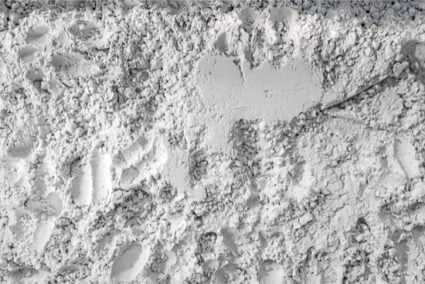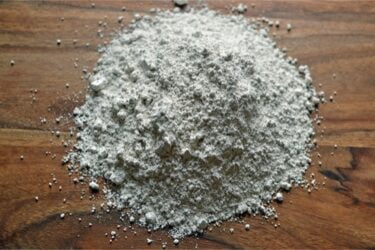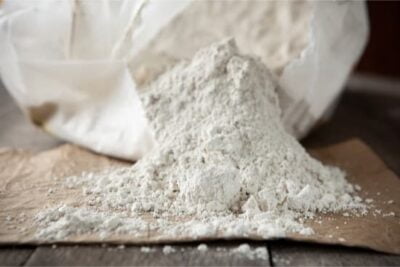Natural bed bug treatments are becoming increasingly popular. The issue is that while some work, others are scientifically unproven and ineffective ideas. Using diatomaceous earth for bed bugs is a popular treatment method, but whether it works is another question.
Diatomaceous earth scratches away the outer waxy layer of bed bugs when they crawl over it. The particles are sharp/solid. The scratching causes them to dry up and die. However, while diatomaceous earth kills bed bugs on contact, they’ve learned to avoid it.
We’ll cover everything you need to know about using diatomaceous earth to kill bed bugs. That includes how it works, how effective it is, how to use it, and what you can use it with to get results.
What is Diatomaceous Earth?
Diatomaceous earth, also known as D.E. or diatomite, is a natural powder made from rock. It’s used in a variety of settings—as a polish, in toothpaste, in cat litter, and to kill bugs.
Like similar natural products, it’s currently popular. People suggest it for everything from health to household use. Whether it really works is another matter.
It’s fine, and white like cornflour. However, it feels different to the touch. While it is soft like all powders, it’s also abrasive and rough.
That’s because it’s made from the ancient, fossilized remains of algae called diatoms. The diatoms died millions of years ago, leaving their tiny shells behind. These fossils compacted to form rocks. That’s why it’s so fine, but also rough.
It’s this quality which means that diatomaceous earth can kill bed bugs.
Does Diatomaceous Earth Work for Bed Bugs?
There’s a common misconception as to why diatomaceous earth kills bed bugs. Some people think it ‘dries them out,’ in the way that putting something in rice dries it out. That isn’t how it works.
Like other bugs, bed bugs have a shell. But their shell isn’t solely for protection. Bed bugs are vulnerable to drying out, because they feed infrequently. Their shell is, therefore, coated with a waxy layer. This layer prevents water evaporating from their bodies.
Diatomaceous earth is effective because it scrapes away this layer. The individual fossilized particles are fine like cornflour. But on a microscopic level, they’re sharp and rough. When a bug climbs over them, they scrape their shell.
It won’t scrape off the entirety of their outer shell. But it creates enough of a gap that lots of moisture escapes. The water evaporates away, quickly drying the bug out. Because of the way it works, it only kills on contact.
Others think that the bed bugs ingest it, and it kills them that way. This idea comes from how cockroaches ingest poisons. The bug walks through the powder, and later ingests it when they groom.
But bed bugs only have a fascicle (a long straw) for a mouth. They also don’t groom themselves. They, therefore, can’t ingest diatomaceous earth. It works solely by scraping away their waxy coating.
Does Diatomaceous Earth Kill Bed Bugs?
The way that it works has been studied and scientifically proven. But diatomaceous earth has mixed results in practice. That’s because diatomaceous earth only kills on contact, and bed bugs have developed coping strategies.
Over millennia, bed bugs have learned to avoid anything toxic or harmful. They have learned to avoid pesticides, and even naturally toxic substances like tea tree oil. This gives them an evolutionary advantage.

According to the journal Insects, this is happening with diatomaceous earth too. Bed bugs take longer to visit areas treated with diatomaceous earth. They would rather visit areas treated with pesticide than D.E.
This limits how effective diatomaceous earth in reality. Because they are repelled, short exposure to D.E. only causes a low mortality rate (about 36%).
It also takes time to work. Water doesn’t evaporate immediately when these small scratches are made. It will take days before the bug dries out, perhaps longer if they aren’t scratched badly.
Does Diatomaceous Earth Attract Bugs?
Bed bugs are attracted to three things. These are heat, CO2 and the smell of people. When they’re hungry, they seek out one or all three. That’s because you give off each of these signals.
Diatomaceous earth doesn’t attract them in any way. The idea is that they have to walk through it to get to where they’re going. Not that they’re lured to it, like other bugs are with glucose baits.
However, some brands of D.E. contain chemicals that encourage movement. Specifically, they contain synthetic bed bug alarm pheromones. These make the bed bugs think they have to run around quickly, and scatter.
These chemicals make bed bugs scatter and scurry around quickly. This makes them walk through the diatomaceous earth more often, enhancing its effects. More bed bugs will die, and they’ll die more quickly. So, while it’s not attractive, there are ways to make it more effective.
How to Apply Diatomaceous Earth Indoors
Unlike DIY sprays, you don’t apply diatomaceous earth directly. Instead, you leave it in places that the bed bugs are likely to find it. This means it’s a low-effort bed bug control method.
However, you can’t leave a pile of D.E. and expect it to lure bed bugs in. You have to think about the ways you use it. Let’s find out how.
Placing your diatomaceous earth in the right place is vital. It should be somewhere that the bed bugs have to go. If you were to put it in the far corner, no bed bugs would go there.
But if you put it in a place that the bed bugs have to go, you’ll kill more of them. Places near to their home are a good choice, as are routes from their home to your bed. Good places to apply diatomaceous earth for bed bugs include:
- Across the entirety of the box spring. Most bed bugs live under the mattress. Covering the box spring means they avoid the area.
- Around the feet of your bed. Bed bugs from around the room will have to walk through it.
- All around nearby furniture. Bed bugs often live on the underside of bedside cabinets.
The majority of infestations are under the mattress. So, spreading D.E. on your box spring means that the bed bugs living there are constantly exposed.
Putting diatomaceous earth around the feet of your bed forces bed bugs to walk through it. Any bed bugs not in your mattress have to climb these feet to reach you, to feed. So, every time they do, they’ll scratch themselves.
Picking the right places also means you can use less. If you were to spread it around the entire room, you’d soon run out. But putting D.E. in these few important places maximizes its effect.
Can You Use Diatomaceous Earth on Your Bed?
Your bed is a prime location to use diatomaceous earth. It’s best to use it underneath your mattress. That’s because the powder will stay in place, making life miserable for your infestation. The bed bugs in your mattress will have no option but to walk through it.
Using at least some on your mattress is necessary. The majority of bugs in an infestation are almost always in the mattress and box spring. To only put D.E. around the feet of your bed would mean you miss these bed bugs.
You can’t spread it on top of your sheets, however, to stop bed bugs biting you at night. Diatomaceous earth is rough, albeit finer than sand or crumbs. It would be uncomfortable for you.
The same applies to putting it underneath your sheets. It would likely spread, and you wouldn’t be able to sleep. Besides, bed bugs get on top of your sheets not underneath them.
How to Use Diatomaceous Earth for Bed Bugs
Using diatomaceous earth is much simpler than other methods. All you have to do is leave it where bed bugs are likely to walk through it.
Begin by identifying where to use it. Then take some powder and put it where there are likely to be the most bugs. Make small piles of it so that the bed bugs are forced to walk across it.
Alternatively, consider sprinkling it. The larger the surface area you cover, the less chance that the bed bugs can avoid it. The only issue is that you would walk through it, and this may be uncomfortable for you.
A dual approach would kill the most bed bugs. But it’s more important to leave D.E. at choke points bed bugs need to pass, than spreading it.
How Much Diatomaceous Earth to Get Rid of Bed Bugs?
The more you use, the better. You want there to be no way for a bed bug to pass without walking through it.
Make a small ring around each foot of your bed. Pile it up enough so that it forms a complete and unbroken ring. It’s when they clamber over it that they scratch themselves.
Diatomaceous earth is quite cheap. There’s no problem with using quite a lot each time you apply it. Buy it in bulk to get the best price.
Whenever you notice that a pile is brushed away, or a path made through it, replenish it. If you’re careful, it might be a week before you notice this happen.
Ways to Kill Bed Bugs with Diatomaceous Earth
Diatomaceous earth is best used in combination with other control methods. While it kills on contact, on its own, it can’t kill large infestations. There will always be some bed bugs that survive.
As such, consider using diatomaceous earth alongside:
- DIY bed bug spray. Mattress sprays made from essential oils kill bed bugs on contact. They’re repellent, so encourage movement, which makes D.E. more effective.
- Pesticide bed bug spray. These sprays linger, killing for weeks. D.E. can help kill off any stragglers.
- Bed bug interceptors. These traps sit around the feet of your bed. Some bed bugs can escape them. Fill them with D.E., and they’ll all die.
Diatomaceous earth is also a useful tool to use after you hire an exterminator. Even an exterminator’s pest control treatment takes weeks to work. Diatomaceous earth will kill any bed bugs that are left over.

How Often Do You Apply Diatomaceous Earth to Kill Bed Bugs?
Diatomaceous earth doesn’t absorb easily into carpets. It doesn’t break down, because the individual grains are solid and abrasive. This means that it lasts longer than other DIY methods.
It will last a long time until you have to replace it. Only by stepping in it and spreading it around will it disappear. Does diatomaceous earth expire? Diatomaceous earth doesn’t expire or go bad. It isn’t made from something degradable like cornflour, for example.
Once you spread it around, your carpet may feel dirty. Consider spreading diatomaceous earth each time after you vacuum. This will keep your carpet clean, but also bed bug free.
Should You Use Diatomaceous Earth in the Home?
It is a decent bed bug control option. The reasons why you should consider using it include:
- It kills bed bugs, unlike many other home remedies. So many home remedies, from cornflour to borax, don’t kill bed bugs. D.E. does.
- It’s entirely natural. Diatomaceous earth contains no synthetic chemicals. It’s pure rock.
- It isn’t harmful to your health when used as advised. Bed bug bombs can harm you if you don’t follow guidelines. D.E. is almost always safe.
- It stays in place after you put it there. Homemade sprays dissipate and stop working after a couple of hours. D.E. stays in place.
But while diatomaceous earth does kill bed bugs, that doesn’t mean it’s a good solution. There are many reasons why you should consider using something else. These are as follows:
- Bed bugs avoid diatomaceous earth. This limits contact, meaning it can never kill them all.
- Bed bugs find a way around diatomaceous earth. They can get up walls or furniture to access you, getting around the D.E.
- On contact, diatomaceous earth doesn’t kill 100% of bed bugs. Considering there are some treatment methods that do, this is a drawback.
- It’s easy to spread around by accident. If you accidentally kick and spread it around, it isn’t effective.
These drawbacks mean that you would kill more bed bugs by picking another treatment method. There are many to choose from, including pesticide sprays, heat treatment and more.
Borax vs. Diatomaceous Earth
Borax (sodium borate) looks similar to diatomaceous earth. It’s often touted as a bed bug killer, but it doesn’t work. If you want to use a powder to kill bed bugs, stick to diatomaceous earth.
Why doesn’t borax kill bed bugs? Because it’s a chemical compound, and breaks down differently to D.E. It’s made from powdered minerals broken down into dust. Diatomaceous earth is created from tiny fossils, which are sharp.
Try rubbing borax between your fingers and compare it to D.E. Diatomaceous earth is sharper and more abrasive.
Will Diatomaceous Earth Stain My Carpet or Clothes?
Diatomaceous earth doesn’t break down easily. If you wet it, the silica it contains doesn’t break down and mix with the water. This limits how much it can ‘stain’ anything.
If you’re worried about staining, consider vacuum cleaning instead of wiping it away with a rag.
Is Diatomaceous Earth Safe to Use?
Diatomaceous earth is non-toxic when ingested, i.e., it can be eaten. Many people eat it for its supposed health benefits, although these are unproven.
However, your concern should be inhalation. Diatomaceous earth can damage the lungs if inhaled. It’s mostly made from amorphous silica, but does contain some crystalline silica. This is difficult for your body to break down when inhaled.
There are also safety concerns related to inhaling certain forms of D.E. Specifically the calcined form of diatomaceous earth can cause pneumoconiosis. Calcination is a process where something is heated and reduced.
In large quantities, D.E. will cause lung problems. You will be more susceptible to pneumonia and similar conditions. Your breath will be shorter. You should be careful when you use it.
- Be careful not to kick up any D.E. dust when you’re placing it down
- Wear a mask when applying diatomaceous earth
- Open a window to allow a little air in after applying D.E
Follow these rules and there’s no practical chance of D.E. causing you health problems.
Pet and Child Safety Precautions
D.E. itself isn’t toxic to children or pets. But when misused, it can be unsafe.
There’s a small risk of misuse if you have pets and/or children in your home. If you have a child, explain to them what diatomaceous earth is and why you’re using it.
To avoid potential problems, keep your bedroom door shut at all times. This will keep both children and pets out, and negate any risk.
Interaction with Medications
As of yet, there is no indication that diatomaceous earth interacts with medications. However, if you are taking medications, you should talk to your doctor. Only they can tell you for sure. You’re likely to be safe either way, however, since you won’t be ingesting it.
It is safe and reasonably effective. However, there are better choices that are as natural, but even more effective. Plus, synthetic pesticides aren’t harmful to your health when used correctly.
Diatomaceous earth isn’t a good choice, even if it does kill bed bugs.


I put Diatomaceous Earth everywhere and I’m still finding live bugs hiding in places. It seems like it’s not working. Ive seen no dead bugs. It’s been 10 days. What did help is sticky traps- just flat sheet type. They seem attracted to them. I placed sticky traps facing down where my bed legs touch the frame making it impossible to reach me on the bed. Trapped 8 in 3 nights. How do you know if they’re all gone? My house has been a nightly battleground of hunting with flashlights and killing them for 6 weeks. There’s less but never quite gone.
Jm,
If you spray orange & clove oil, it’ll force the bugs to come out of hiding. This is a great way to Know if they are all gone or not.
I’m curious if you are now sleeping soundly… we have been in the battle for 8 weeks. Used lots of DE … found a lot of dried skeletons and bugs. Encased the box springs and mattress. Used sticky tape around the sides of both. Found 1 tiny one yesterday on the side of the box springs… not fed. Exhausted
I dealt with an infestation years ago and the powder stuff worked for me. Sprinkled every inch of mattress and frame plus bed flooring. I think I eliminated infestation in a week.
Did you do a light dusting or was your application visible? I’ve been seeing a lot of contradictory advice over the internet. Thanks.
I used heat to get rid of the bugs in my bedroom. Rented a heating unit for about $170 for one day. Had the temp up to 140-150 for about 6 hours. Bugs were gone. Then I bought a unit to treat it again 2 weeks later just to be sure and to help out some friends with the same problem.